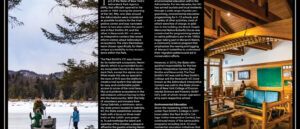The Paul Smith’s Visitor Interpretive Center (VIC)

 The VIC was originally a project of the State of New York’s Adirondack Park Agency (APA), that officially opened to the public in 1989. During the planning of the VIC, fifty-one sites around the Adirondacks were considered as possible locations for the interpretive center and was narrowed down to two sites within the park— one in Paul Smiths, NY, and the other in Newcomb, NY—to serve as interpretive centers that would inform visitors about Adirondack ecosystems. The sites themselves were chosen specifically for their unique accessibility to key ecosystems within the Park.
The VIC was originally a project of the State of New York’s Adirondack Park Agency (APA), that officially opened to the public in 1989. During the planning of the VIC, fifty-one sites around the Adirondacks were considered as possible locations for the interpretive center and was narrowed down to two sites within the park— one in Paul Smiths, NY, and the other in Newcomb, NY—to serve as interpretive centers that would inform visitors about Adirondack ecosystems. The sites themselves were chosen specifically for their unique accessibility to key ecosystems within the Park.
The Paul Smith’s VIC was chosen for its trademark ecosystem, Heron Marsh, which is surrounded by every ecosystem found in the Adirondack Park, except the alpine zone. What made this site so special in the eyes of NYS was the ability to create a trail system that allowed for easy and comfortable public access to some of the most beautiful and pristine ecosystems in the Adirondacks without having to hike into the backcountry. With the help of volunteers and inmates from Camp Gabriels, a minimum-security state prison located in Gabriels, NY, the State established several trails with a focus on three main trails on the 3,000-acre property. To acknowledge the talent and expertise of the inmates, a plaque is affixed to the gazebo entering Heron Marsh, Barnum Brook and Boreal Life Trail adjacent to the public parking lot that recognizes their work.
The VIC opened in 1989 as State-funded facility with the vision of being a premier destination for environmental education within the Adirondacks. For two decades, the VIC has served tourists and local residents through a wide range of public programming, environmental education programming for K-12 schools, and a variety of other activities, most of which were free of charge. In addition to the building, the Breck Chapin Memorial Native Butterfly House was constructed for programming related to native pollinators and in the 1990s began taking part in Monarch Watch, a community science program that emphasizes the rearing and tagging of Monarch butterflies to understand their migration patterns and aid in conservation efforts.
However, in 2010, the State relinquished responsibility for the two Visitor Interpretive Centers (Paul Smiths and Newcomb). The Paul Smith’s VIC was sold to Paul Smith’s College and the Newcomb VIC (now known as the Adirondack Interpretive Center) was sold to the State University of New York College of Environmental Science and Forestry (SUNY ESF), both of which remain operational by each respective school.
Environmental Education
Since the reopening of the VIC under Paul Smith’s College in 2011 (now called the Paul Smith’s College Visitor Interpretive Center), has continued many of the same public programs including its K-12 environmental education initiatives that were popular under State management and has added a variety of new popular programs led by volunteers, staff and Paul Smith’s College faculty.
It has retained free public access to the trails during the summer season and fee-based access to trails in the winter months to support the VIC as a popular Nordic Ski Center with groomed trails. There are now more than 30 miles of established trails that are used for hiking, snowshoeing and skiing. Additionally, the Paul Smith’s College VIC has branched out into the arts and research, become a hub for life-long learning and is a regionally renowned Nordic Ski Center that hosts the Paul Smith’s College Nordic Team at its new Biathlon Range and holds several collegiate races annually.
The VIC lies just a mile north of Paul Smith’s College campus and is often referred to as a “hidden gem in the heart of the Adirondacks.” Walking through the front doors of the Frank M. Hutchins Lodge—renamed in 2022 to honor Frank Hutchins, a longtime volunteer and supporter of the educational mission of the VIC—feels equivalent to passing through a portal to another world that is often described as smelling like balsam fir.
Front desk staff are often met with “wows” and “I didn’t know this place existed” as they admire the buildings impressive architecture, look out of the wall of windows facing Heron Marsh and St. Regis Mountain and peruse Heron Marsh Gallery that is decorated with paintings and photographs from local artists.
The VIC serves as one of the initial points of contact for people who are visiting the park for the first time, providing trail information on-site, and recommendations for local places to visit, dine, and explore. Since coming under the management of the College, the VIC provides exceptional learning opportunities for students and classes and has been leveraged as a resource for prospective students who are considering attending Paul Smith’s College.
Original Trails
The VIC trails are open seven days a week from dawn to dusk and free in the summer, with a fee-based trail pass system operating during the winter months.
The three original trails, Heron Marsh, Barnum Brook and Boreal Life Trail allow visitors to traverse boreal bogs, marshes and mixed forests. Heron Marsh, a three-mile loop features several points of interest including a floating bridge over the Marsh where visitors often see a variety of waterfowl and wildlife including beavers and otters.
It features a nearly 600-foot boardwalk through a bog that gives hikers first-hand looks at some of the most interesting plants including pitcher plants and sundews, which are both carnivorous. Another highlight of our bog trails includes a close look at tamarack trees, a deciduous conifer—a tree that has needles, but loses them in the fall, just like deciduous trees—that are unique to northern forests like those in the Adirondacks.
Barnum Brook is a 0.6-mile, Americans with Disabilities Act (ADA) accessible trail that allows visitors in wheelchairs, baby strollers, and other disabilities to still access Heron Marsh, walk on bridges that hover above Barnum Brook and the newly installed Forest Megaphone which was the final product of a Paul Smith’s College student capstone project which aimed to identify the best spot on the VIC property (that was also easily accessible) to hear the natural sounds of environment.
Lastly, Boreal Life Trail is a popular hiking loop that was recently designated as a New York State Birding Trail. The trail is located on the northern most border of the property and gets hikers out on an 800-foot boardwalk that is built through a boreal forest and bog. Here you walk along Barnum Brook again, and eventually to the viewing platform at Barnum Pond. From the platform you can see one of the most pronounced areas of ecological succession at the VIC, characteristics by a gradient of shorter tamarack and black spruce within the bog leading to taller White Pines and mixed forest in the background. You can get an unrestricted view of Jenkins Mountain, the only mountain on the VIC property sitting at 2,513 feet above elevation.